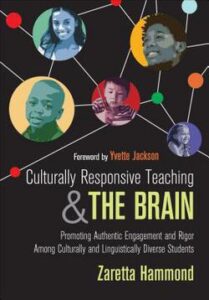Culturally Responsive Teaching and the Brain

Culturally Responsive Teaching and The Mind: Marketing Authentic Engagement and Rigor Among the Culturally and Linguistically Various Students
By Zaretta Hammond
(Corwin, 2015 – Understand more)
Reviewed by Invoice Ivey
 Culturally Responsive Educating and the Mind has become 1 of the much better recognized go-to texts for academics interested in carrying their equity function further and analyzing the state of mind desired to put that operate to apply in the classroom. And deservedly so.
Culturally Responsive Educating and the Mind has become 1 of the much better recognized go-to texts for academics interested in carrying their equity function further and analyzing the state of mind desired to put that operate to apply in the classroom. And deservedly so.
 Previous summer I was a single of the facilitators of NENTS 2., a four-day summer workshop for early profession lecturers supplied by the Connecticut Affiliation of Unbiased Faculties and the Association of Impartial Faculties of New England, and we required the text as progress studying for all our participants.
Previous summer I was a single of the facilitators of NENTS 2., a four-day summer workshop for early profession lecturers supplied by the Connecticut Affiliation of Unbiased Faculties and the Association of Impartial Faculties of New England, and we required the text as progress studying for all our participants.
We benefit Zaretta Hammond’s blend of a distinct explanation of mind-based mostly understanding from a cultural perspective and a obvious description of how it looks in action. Whilst we in NENTS 2. function with early occupation instructors, I found the reserve on 1st go through to also be valuable to me as a late-mid occupation instructor, and I consider it can be beneficial to teachers of all ages and activities.
The book’s composition
1. Introduction
2. Creating Consciousness and Knowledge
a. Climbing Out of the Gap
b. What is Culture Received to Do with It?
c. This Is Your Brain on Society
d. Making ready to Be a Culturally Responsive Practitioner
3. Developing Understanding Partnerships a-c
a. Developing the Basis of Understanding Partnerships
b. Setting up Alliance in the Discovering Partnership
c. Shifting Tutorial Mentality in the Discovering Partnership
4. Constructing Intellective Capacity
a. Information Processing to Make Intellective Capacity
b. Building a Culturally Responsive Neighborhood for Studying
5. Epilogue
6. Glossary
7. References and More Looking at
8. Index
Every chapter ends with three bulleted lists: a chapter summary, an invitation to inquiry, and means to go deeper.
Recognition, Discovering Partnerships, Info Processing, and Neighborhood
The to start with chapter introduces Zaretta Hammond’s All set for Rigor framework: Consciousness, Studying Partnerships, Info Processing, and Community of Learners and Studying Natural environment (pp.17-20). In explaining the framework, Hammond will make the pursuing key points (between many others!):
- In setting up awareness, we will need to comprehend how the brain learns, know and own our very own cultural lenses, and know and have an understanding of the three concentrations of tradition.
- We will need to rethink scholar and teacher interactions as a partnership, aiding each scholar establish a feeling of self-efficacy.
- We will need to integrate oral traditions with other strategies of information and facts processing, and provide learners with genuine alternatives to method written content.
- And we want to ensure college students really feel safe and sound and have voice and company. (Hammond, p.17)
By way of the reserve Hammond develops just about every of these details in bigger depth, like a in depth description of the brain and how it features. At the end of Chapter 1, we are invited to mirror on how our educational institutions are addressing the desires of minimal-executing college students of shade, how we individually support pupils in getting to be independent learners, and how we and our colleagues can ‘operationalize’ the principles of culturally responsive instructing (Hammond, p.20).
I identified each of these reflection details to be valuable not just as a personal test on what my requires and individuals of my faculty really are, but also as a way of moving a great deal of her information into lengthier term storage.
Wanting into Individualistic and Collectivist Cultures
I also uncovered particularly practical – the two for myself and for the early career academics with whom I was operating – the facts on individualism and collectivism in chapter 2 (pp.25-28), and the part on “Becoming a Heat Demander” in Chapter 6 (pp.97-99).
Analyzing additional deeply the qualities of individualistic cultures (this kind of as the United States) and collectivist cultures (these as South Korea) aided me to have an understanding of more extensively the roots of a lot of of the cultural discrepancies I see in my university, and further than.
Searching at the chart of traits of teachers who may perhaps be classified as heat demanders, technocrats, sentimentalists, and elitists aided me face up to aspects of my educating personality that might, on the other hand unintentionally, undermine my efficiency and believe about what methods I could take.
Neuroscience and Tradition
Each chapter in this e book is practical – packed with information and facts about neuroscience and what a definitely culturally responsive method seems to be like and why it is so productive. Culturally Responsive Educating and the Mind incites teachers of all ages to reflect on how greatest we can guidance our pupils. No surprise it is so often encouraged.
Invoice Ivey (he/any) is Center School Dean and teaches Humanities 7, Rock Band, and Educational Abilities at Stoneleigh-Burnham Faculty, a gender inclusive ladies university for grades 7-12 in Western Massachusetts. He also serves on the NELMS Board of the Administrators as an advisor for fairness, inclusion, and social justice, and on the AMLE Fairness in Center Grades Education and learning Committee. See Bill’s other MiddleWeb reviews and content right here.




